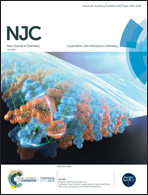Functionalizing benzothiadiazole with non-conjugating ester groups as side chains in a donor–acceptor polymer improves solar cell performance†
Abstract
Herein, the effect of non-conjugated ester functionalization at the 5,6-position of 2,1,3-benzothiadiazole (BT) in a donor (D)–acceptor (A) conjugated polymer (CP) used for photovoltaic devices has been investigated. Positions 5 and 6 of BT were functionalized with methyl acetate groups and the structure property relationship was compared to BT with methyl groups at the 5 and 6 positions in four types of D–A CPs. Alternate co-polymers of newly synthesized methyl and methyl acetate derivatives of BT and Th–BT–Th with commonly used donors such as dithiophene (DTh) and benzodithiophene (BDT) were synthesized using Stille coupling reactions: namely, P(1,2,3,4)-Me and P(1,2,3,4)-Ac. All CPs were extensively characterized using GPC, UV-visible, 1H-NMR, 13C-NMR, TGA and CV. The optimized geometry, along with changes in the dihedral angle upon substitution with acetate groups, was analyzed by density functional theory (DFT) using B3LYP/6-31G(d,p). The side chain ester groups lower the dihedral angle, improve the optical and electrochemical properties of CPs in polymer solar cells (PSCs), improve phase separation of the active layer and performance of the fabricated PSCs compared to methyl counterparts, as investigated for P(1,2,3,4)-Me and P(1,2,3,4)-Ac. Upon fabrication of a BHJ solar cell with ITO/PEDOT:PSS/P-PC71BM/LiF/Al device geometry, CPs with methyl acetate functionalization (P2-Ac, P3-Ac and P4-Ac) resulted in higher PCEs of 1.36%, 1.17% and 0.35%, compared to their methyl counterpart CPs, P2-Me, P3-Me and P4-Me, which exhibited PCEs of 0.9%, 0.54% and 0.31%, respectively. With 1,8-diiodooctane (DIO) as an additive, a higher PCE of 1.96% was achieved for P3-Ac. Atomic force microscopy (AFM) and thin film X-ray diffraction (XRD) were used to determine the impact of side chain ester groups on π–π stacking distance among CP main chains in the film state and the morphology of the active layer of the fabricated PSCs, respectively.



 Please wait while we load your content...
Please wait while we load your content...